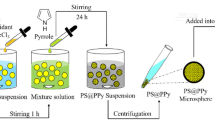Abstract
Abstract This paper reports an easy and effective way to fabricate polystyrene/poly (N-isopropylacrylamide) (PS/ PNIPAM) core-shell particles and PNIPAM hollow spheres. The main point of the method is to take advantage of the hydrophobic interaction between initiator and PS particles. The hydrophobic azodiisobutyronitriles automatically concentrate around the PS particles and initiate polymerization of N-isopropylacrylamide (NIPAM) and the crosslinkermethylene bisacrylamide (MBA), which dissolve in the aqueous phase, at the surface of the PS nanoparticles. Then, PNIPAM adheres to the PS particles to form a coreshell structure as a result of their hydrophobic interaction. This interaction is due to the unique property of PNIPAM, namely, its ability to transition from hydrophilic to hydrophobic when the temperature rises to 32°C. Furthermore, the hollow PNIPAM spheres were obtained by etching the PS core with chloroform.
Similar content being viewed by others
References
Jeong B, Bae Y H, Lee D S, Kim S W. Biodegradable block copolymers as injectable drug-delivery systems. Nature, 1997, 388: 860–862
Kurisawa M, Terano M, Yui N. Doublestimuli-responsive degradable hydrogels for drug delivery: interpenetrating polymer networks composed of oligopeptide-terminated poly (ethylene glycol) and dextran. Macromol Rapid Commun, 1995, 16: 663–666
Brøndsted H, Kopecek J. Drug delivery to the colon: in vitro and in vivo degradation. Pharm Res, 1992, 9: 1540–1545
Miyata T, Asami N, Uragami T. Preparation of an antigensensitive hydrogel using antigen-antibody bindings. Macromolecules, 1999, 32: 2082–2084
Holtz J H, Asher S A, Munro C H, Asher S A. Intelligent polymerized crystalline colloidal arrays: novel chemical sensor materials. Anal Chem, 1998, 70: 780–791
Holtz J H, Asher S A. Polymerized colloidal crystal hydrogel films as intelligent chemical sensing materials. Nature, 1997, 389: 829–832
Ouali L, Stoll S, Pefferkorn E, Elaissari A, Lanet V, Pichot C, Mandrand B. Coagulation of antibody-sensitized latexes in the presence of antigen. Polym Adv Technol, 1995, 6: 541–546
Heskins M, Guillet J E. Solution properties of poly(N-isopropylacrylamide). J Macromol Sci Chem, 1968, 8: 1441–1455
Yan L, Yu M, Markus D, Matthias B. Thermosensitive coreshell particles as carriers for Ag nanoparticles: modulating the catalytic activity by a phase transition in networks. Angew Chem Int Ed, 2006, 45: 813–816
Chen C W, Chen M Q, Takeshi S, Mitsuru A. In-site formation of silver nanoparticles on poly(N-isopropylacrylamide)-coated polystyrene microspheres. Adv Mater, 1998, 10(14): 1122–1126
Sun Q H, Deng Y L. Encapsulation of polystyrene latex with temperature-responsive poly(N-isopropylacrylamide) via a self-assembling approach and the adsorption behaviors therein. Langmuir, 2005, 21: 5812–5816
Dingenouts N, Seelenmeyer S, Deike I, Rosenfeldt S, Ballau M, Lindner P, Narayanan T. Analysis of thermosensitive coreshell colloids by small-angle neutron scattering including contrast variation. Phys Chem Chem Phys, 2001, 3: 1169–1174
Cheng Y, Jayachandran N K, Donald E B, Fan J, Chi W. Laser-light-scattering study of internal motions of polymer chains grafted on spherical latex particles. J Phys Chem B, 2004, 108: 18479–1848
Thomas H, Charles D D, Wolfgang E, Charles D D, Wolfgang E, Karl K. PNIPAM-co-polystyrene core-shell microgels: structure, swelling behavior, and crystallization. Langmuir, 2004, 20: 4330–4335
Zha L S, Zhang Y, Yang W L, Fu S. Monodisperse temperature-sensitive microcontainers. Adv Mater, 2002, 14: 1090–1092
Zou D Z, Sun L Q, Aklonis J J. Model filled polymers. VIII: Synthesis of crosslinked polymeric beads by seed polymerization. J Polym Sci Part A: Polymer Chemistry, 1992, 30: 1463–1475
Kim S H, Son W K, Kim Y J, Kang E, Kim D. Synthesis of polystyrene/poly(butyl acrylate) core-shell latex and its surface morphology. J Appl Polym Sci, 2003, 88: 595–601
Author information
Authors and Affiliations
Corresponding author
Additional information
__________
Translated from Journal of Nanjing University (Natural Sciences), 2007, 43(5): 483–488 [译自: 南京大学学报(自然科学)]
Rights and permissions
About this article
Cite this article
Zhu, D., Wang, F., Gao, C. et al. Construction of PS/PNIPAM core-shell particles and hollow spheres by using hydrophobic interaction and thermosensitive phase separation. Front. Chem. Eng. China 2, 253–256 (2008). https://doi.org/10.1007/s11705-008-0049-5
Published:
Issue Date:
DOI: https://doi.org/10.1007/s11705-008-0049-5




